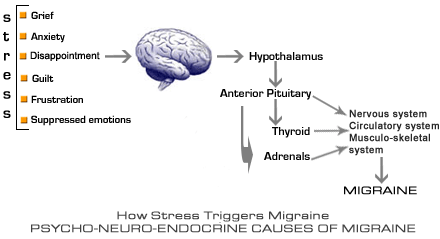- Our Location
- #604 1087 2nd Ave NW CALGARY ALBERTA,
POSTAL CODE T2N 5B2 Canada
- working hours
- Mon - Fri : 9:00 Am - 5:00 Pm
- Our Location
- #604 1087 2ND AVE NW CALGARY ALBERTA,
POSTAL CODE T2N 5B2 CANADA
- working hours
- Mon - Fri : 9:00 Am - 5:00 Pm
Migraine: What it is? Types of Migraine
Migraine is a symptom complex of periodic headaches which are usually unilateral (one sided) and often associated with nausea, vomiting, increased sensitivity to noise and light. The attack of migraine is usually preceded by constriction (narrowing) of the cranial vessels (blood vessels supplying the brain and skull) and the headache commences with dilatation of these blood vessels. The attacks of migraine tend to be recurrent and the severity of attacks usually decreases as the patient ages.
There are two main types of migraine:
1) Migraine with Aura (Classic Migraine):
This type of headache is characterized by neurological phenomenon (aura) that is experienced 10 to 30 minutes before the headache begins. Auras may be experienced as visual disturbances, hallucinations or even temporary loss of vision before the headache. . Some other common expressions of the aura may be in the form of giddiness, vertigo, tingling numbness in various parts of the body, weakness, difficulty in speech, etc. Auras are experienced due to the constriction of the cranial blood vessels prior to the commencement of the migraine.
2) Migraine without Aura (Common Migraine):
This is a common presentation and here the patient does not experience any aura (neurological phenomena) before the headache. Nausea and vomiting frequently accompany this kind of migraine. General fatigue and lethargy may be experienced before the headache begins.
There are some other types of Migraine which are not so common:
01 Basilar
02 Ophthalmic
03 Ophthalmoplegic
04 Retinal
05 Status migraine
Migraine headaches usually begin gradually over a particular area on one side of the head. The pain then builds up in intensity over a couple of hours and spreads over a larger area of the head. The pain tends to subside gradually over a few hours in most of the cases but may even last up to a few days in some cases.
Migraine Causes

The exact cause of migraine is not understood in totality. It is caused by disturbance in the functioning of the nervous system which may be triggered by environmental factors or changes in the body itself. Migraine tends to run in families which shows that genetics have a role to play in the development of migraine.
In many women, migraine tends to recur at some point of their menstrual cycles regularly, either before, during or after the menses. This is known as menstrual migraine and it is related to the hormonal changes that occur in the body during the menstrual cycle. Menstrual migraines tend to disappear during pregnancy.
There are certain common factors which trigger the onset of migraine in many patients. These are as follows:
- Weather changes
- Hormonal changes before, during and after the menses in women
- Alcohol
- Birth control pills
- Inadequate sleep
- Physical or mental stress
- Irregular meals or skipping a meal
- Strong odors
- Certain food articles
- Environmental changes
- Excess of noise or light
Once identified, the patient must modify his lifestyle so as to avoid these triggers wherever possible.

Migraine Symptoms
Migraine headache is usually described as a throbbing and pulsating pain that is usually felt on one side of the head. The pain is worsened by any strenuous activity, stooping, exertion and mental activity. The pain begins in one area of the head, usually on any one side and then spreads all over the head. The intensity of the pain builds up and attains peak in 1-2 hours. The duration of the migraine varies from a few hours to a couple of days in some cases. Normal routine is disrupted due the pain and the patient may find difficulty in falling asleep.
There may be few other symptoms which accompany the headache, common ones include nausea, vomiting, increased sensitivity to light and noise, irritability, etc. Strong odors may also worsen the pain in some patients.
Aura (neurological phenomenon)
It is experienced by many and these could be in the form of bright lights around objects, zig-zag lines and waves in front of the eyes, temporary loss of vision, visual hallucinations, etc. All patients do not experience aura and some have just transient mood changes and lethargy before the pain begins.
Basilar artery migraine:
This type of migraine is characterized by disturbances in the basilar artery which leads to severe headache, giddiness, difficulty in speech, double vision, muscular problems, etc.
Ophthalmic migraine:
A type of migraine in which headache is accompanied by paralysis of the muscles of the eyes.
Retinal migraine:
In this type of migraine the ocular symptoms are predominant due to constriction (narrowing) of one or more retinal arteries.
Status migraine:
Rare type of migraine in which intense pain lasts for more than 72 hours.
ORDER TREATMENT ONLINE
Our Homeopathy treatment is now just a few clicks away.
(Treatment for additional diseases charged at 50%)

 Find
out the chances
Find
out the chances
of cure (Free)

